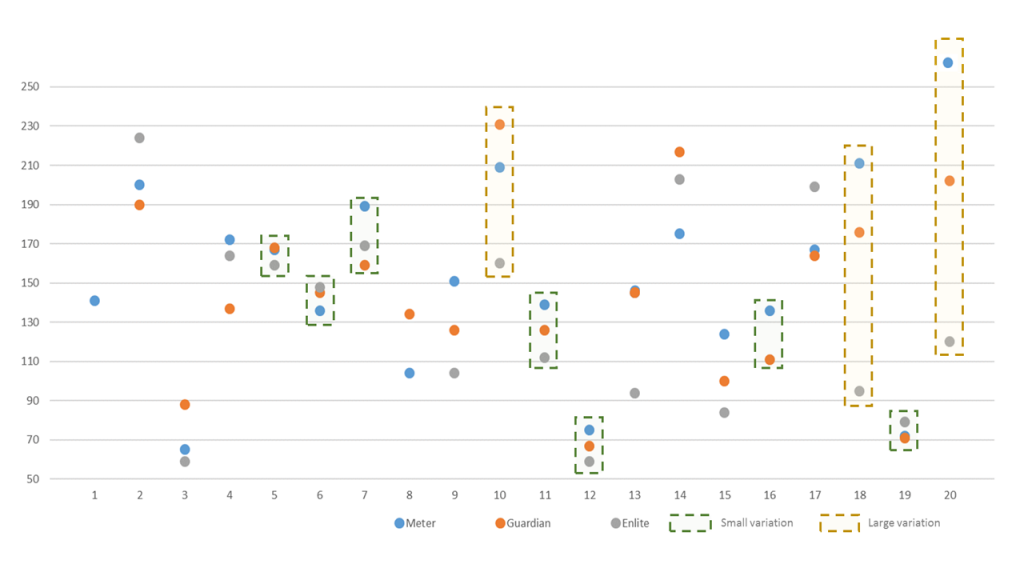Running Diabetes: The Guardian versus the Enlite sensors: Test #2
[vc_row padding_top=”0px” padding_bottom=”0px”][vc_column fade_animation_offset=”45px” width=”1/6″][text_output] [/text_output][/vc_column][vc_column fade_animation_offset=”45px” width=”2/3″ id=”” class=”” style=””][text_output]
[/text_output][/vc_column][vc_column fade_animation_offset=”45px” width=”2/3″ id=”” class=”” style=””][text_output]
Alright, here is the second part of my sensor experiment. You can find the first part of the test here. For this second test, I decided to record some additional information regarding the calibrations as well as, like the previous post, taking more pictures of the trends.
[/text_output][/vc_column][vc_column fade_animation_offset=”45px” width=”1/6″][/vc_column][/vc_row][vc_row padding_top=”0px” padding_bottom=”0px”][vc_column fade_animation_offset=”45px” width=”1/1″][text_output]

[/text_output][/vc_column][/vc_row][vc_row padding_top=”0px” padding_bottom=”0px”][vc_column fade_animation_offset=”45px” width=”1/1″][text_output] [/text_output][/vc_column][/vc_row][vc_row padding_top=”0px” padding_bottom=”0px”][vc_column fade_animation_offset=”45px” width=”1/6″][text_output]
[/text_output][/vc_column][/vc_row][vc_row padding_top=”0px” padding_bottom=”0px”][vc_column fade_animation_offset=”45px” width=”1/6″][text_output] [/text_output][/vc_column][vc_column fade_animation_offset=”45px” width=”2/3″][text_output]
[/text_output][/vc_column][vc_column fade_animation_offset=”45px” width=”2/3″][text_output]
- Calibrations 2,3,8,15,20 for Guardian sensor, for a 75% of good reading within the tolerance. And Calibrations 9, 10, 11, 12, 13, 15, 17, 19, 20 for 50% of readings at calibration within the tolerance in the case of the Enlite sensor.
- The Enlite sensor got worse in comparison to the calibration as the days went by. While the opposite happened with the Guardian, which after the 4th calibration it stayed pretty much within all the way until the last calibration or end of life of the sensor.
- There were 5 occasions in which the sensors were on opposite sides of the calibration. Meaning that when the Guardian was registering lower than calibration, the Enlite sensor was showing up higher. This was very noticeable in 3 of the 5, calibration 2, 10 and 13. Calibration number 13 is one that it will call for a different call of actions depending on which reading you take as a true reading.
- The average deviation difference between the two is about 16.34 higher for the Enlite sensor.
- While the maximum deviation from calibration reading was also higher for the Enlite sensor by 82 points. With a standard deviation difference of around 21 higher for the Enlite, making it a little bit more spread in the reading compared to the calibration readings.
[/text_output][/vc_column][vc_column fade_animation_offset=”45px” width=”1/6″][/vc_column][/vc_row][vc_row padding_top=”0px” padding_bottom=”0px”][vc_column fade_animation_offset=”45px” width=”1/1″][text_output]

[/text_output][/vc_column][/vc_row][vc_row padding_top=”0px” padding_bottom=”0px”][vc_column fade_animation_offset=”45px” width=”1/1″][text_output]

[/text_output][/vc_column][/vc_row][vc_row padding_top=”0px” padding_bottom=”0px”][vc_column fade_animation_offset=”45px” width=”1/1″][text_output]

[/text_output][/vc_column][/vc_row][vc_row padding_top=”0px” padding_bottom=”0px”][vc_column fade_animation_offset=”45px” width=”1/1″][text_output] [/text_output][text_output]
[/text_output][text_output]

[/text_output][/vc_column][/vc_row][vc_row padding_top=”0px” padding_bottom=”0px”][vc_column fade_animation_offset=”45px” width=”1/1″][text_output] [/text_output][/vc_column][/vc_row][vc_row padding_top=”0px” padding_bottom=”0px”][vc_column fade_animation_offset=”45px” width=”1/1″][text_output]
[/text_output][/vc_column][/vc_row][vc_row padding_top=”0px” padding_bottom=”0px”][vc_column fade_animation_offset=”45px” width=”1/1″][text_output] [/text_output][text_output]
[/text_output][text_output]

[/text_output][/vc_column][/vc_row][vc_row padding_top=”0px” padding_bottom=”0px”][vc_column fade_animation_offset=”45px” width=”1/1″][text_output] [/text_output][/vc_column][/vc_row][vc_row padding_top=”0px” padding_bottom=”0px”][vc_column fade_animation_offset=”45px” width=”1/1″][text_output]
[/text_output][/vc_column][/vc_row][vc_row padding_top=”0px” padding_bottom=”0px”][vc_column fade_animation_offset=”45px” width=”1/1″][text_output] [/text_output][/vc_column][/vc_row][vc_row padding_top=”0px” padding_bottom=”0px”][vc_column fade_animation_offset=”45px” width=”1/1″][text_output]
[/text_output][/vc_column][/vc_row][vc_row padding_top=”0px” padding_bottom=”0px”][vc_column fade_animation_offset=”45px” width=”1/1″][text_output] [/text_output][/vc_column][/vc_row][vc_row padding_top=”0px” padding_bottom=”0px”][vc_column fade_animation_offset=”45px” width=”1/1″][text_output]
[/text_output][/vc_column][/vc_row][vc_row padding_top=”0px” padding_bottom=”0px”][vc_column fade_animation_offset=”45px” width=”1/1″][text_output] [/text_output][/vc_column][/vc_row][vc_row padding_top=”0px” padding_bottom=”0px”][vc_column fade_animation_offset=”45px” width=”1/6″][text_output]
[/text_output][/vc_column][/vc_row][vc_row padding_top=”0px” padding_bottom=”0px”][vc_column fade_animation_offset=”45px” width=”1/6″][text_output] [/text_output][/vc_column][vc_column fade_animation_offset=”45px” width=”2/3″][text_output]
[/text_output][/vc_column][vc_column fade_animation_offset=”45px” width=”2/3″][text_output]
[/text_output][/vc_column][vc_column fade_animation_offset=”45px” width=”1/6″][/vc_column][/vc_row][vc_row padding_top=”0px” padding_bottom=”0px”][vc_column fade_animation_offset=”45px” width=”1/1″][text_output] [/text_output][/vc_column][/vc_row]
[/text_output][/vc_column][/vc_row]